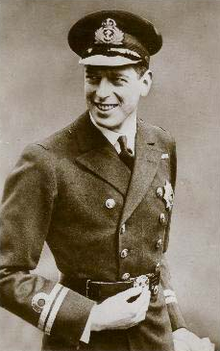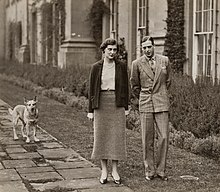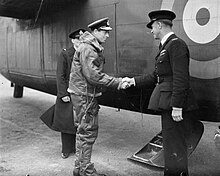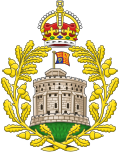Prince George, Duke of Kent
This article needs additional citations for verification. (May 2010) |
| Prince George | |||||
|---|---|---|---|---|---|
 | |||||
| Duke of Kent | |||||
| Successor | Prince Edward | ||||
| Born | 20 December 1902 York Cottage, Sandringham | ||||
| Died | 25 August 1942 (aged 39) Morven, Scotland | ||||
| Burial | 29 August 1942 | ||||
| Spouse | Princess Marina of Greece and Denmark | ||||
| Issue | Prince Edward Lady Ogilvy Alexandra Prince Micheal | ||||
| |||||
| House | House of Windsor House of Saxe-Coburg and Gotha | ||||
| Father | George V | ||||
| Mother | Mary of Teck | ||||
The Prince George, Duke of Kent KG KT GCMG GCVO (George Edward Alexander Edmund; 20 December 1902 – 25 August 1942) was a member of the British Royal Family, the fourth son and fifth child of King George V and Queen Mary, and younger brother of Kings Edward VIII and George VI. He held the title of Duke of Kent from 1934 until his death in a military air-crash. His death, on 25 August 1942, marked the first death of a member of the Royal Family on active service in 400 years.[1]
Early life
Prince George was born on 20 December 1902 at York Cottage on the Sandringham Estate in Norfolk, England.[2] His father was George, Prince of Wales (later King George V), the eldest surviving son of King Edward VII and Queen Alexandra. His mother was the Princess of Wales (later Queen Mary), the daughter of The Duke and Duchess of Teck.[3] At the time of his birth, he was fifth in the line of succession behind his father and three older brothers. As a grandchild of the British monarch in a male line, he was styled His Royal Highness Prince George of Wales.
He was baptised in the Private Chapel at Windsor Castle on 26 January 1903 by Francis Paget, Bishop of Oxford. Unlike previous royal baptisms, George was christened using ordinary water rather than water from the River Jordan.[4]
Education and career
Prince George received his early education from a tutor and then followed his elder brother, Prince Henry (later the Duke of Gloucester), to St. Peter's Court Preparatory School at Broadstairs, in Kent. At the age of thirteen, like his brothers, the Prince of Wales (later King Edward VIII) and Prince Albert (later King George VI), before him, he went to naval college, first at Osborne and, later, at Dartmouth.[2] He remained in the Royal Navy until March 1929, serving on HMS Iron Duke and later HMS Nelson.[2] After leaving the navy, he briefly held posts at the Foreign Office and later the Home Office, becoming the first member of the royal family to work as a civil servant.[2]
From January to April 1931 Prince George and his elder brother the Prince of Wales travelled 18,000 miles on a tour of South America, voyaging out on the ocean liner SS Oropesa[5] and returning via Paris and an Imperial Airways flight from Paris–Le Bourget Airport that landed specially in Windsor Great Park.[6][7]
In October 1938 George was appointed Governor General of Australia in succession to Lord Gowrie with effect from November 1939.[8][9] On 11 September 1939 it was announced that, owing to the outbreak of World War II, the appointment was postponed.[10]
In 1939 George was elected Grand Master of the United Grand Lodge of England, an office he held until his death.[11]
At the start of World War II, George returned to active military service in the rank of Rear Admiral, briefly serving on the Intelligence Division of the Admiralty. In April 1940, he transferred to the Royal Air Force. He temporarily relinquished his rank as Air Vice-Marshal (the equivalent of Rear Admiral) to assume the post of Staff Officer at RAF Training Command in the rank of Group Captain.
Marriage

On 12 October 1934, in anticipation of his forthcoming marriage to his second cousin Princess Marina of Greece and Denmark he was created Duke of Kent, Earl of St Andrews and Baron Downpatrick.[3][12][13] The couple married on 29 November 1934 at Westminster Abbey.[14] The bride was a daughter of Prince Nicholas of Greece and Denmark and a great-niece of Queen Alexandra.[15] It was the last marriage to date between a son of a Commonwealth sovereign and a member of a foreign royal house. Princess Elizabeth (later Queen Elizabeth II), daughter of King George VI, married Marina's cousin and fellow Greek dynast, Prince Philip of Greece and Denmark, in November 1947, making that the last marriage between the Commonwealth and other royal families.
Princess Marina became known as HRH The Duchess of Kent following the marriage. She and her husband had three children:
- Prince Edward of Kent (born 9 October 1935)
- Princess Alexandra of Kent (born 25 December 1936)
- Prince Michael of Kent (born 4 July 1942)
Personal life
Both before and after his marriage, Prince George had a string of affairs with both men and women, from socialites to Hollywood celebrities. The better known of his lovers included banking heiress Poppy Baring, socialite Margaret Whigham (later Duchess of Argyll and involved in a notoriously scandalous divorce case), and Barbara Cartland (who believed him to be the father of her daughter Raine McCorquodale).[16] There were "strong rumors" that he had affairs with musical star Jessie Matthews[17] and Noël Coward,[18] a relationship which Coward's long-term boyfriend, Graham Payn, denied.[19] The security services "reported that Coward and Kent had been seen parading together through the streets of London, dressed and made up as women, and had once been arrested by the police for suspected prostitution".[20]
The Duke of Kent is rumoured to have been addicted to drugs, especially morphine and cocaine, a rumour which reputedly originated with his friendship with Kiki Preston[21] (see below). His brother, the Prince of Wales, was deputed to cure him of during the latter part of the 1920s.[citation needed] Other alleged sexual liaisons were with his distant cousin Louis Ferdinand, Prince of Prussia, and the art historian and Soviet spy Anthony Blunt,[22][17] and reportedly was blackmailed by a male prostitute to whom he wrote intimate letters.[citation needed] The Duke courted Princess Juliana of the Netherlands without success.[citation needed]
In addition to his legitimate children, the Duke is said to have had a son by Kiki Preston (née Alice Gwynne, 1898–1946), an American socialite with whom he reportedly shared a ménage à trois with Jorge Ferrara, the bisexual son of the Argentine ambassador to the Court of St James's. Known as "the girl with the silver syringe", drug-addict Preston – a cousin of railroad heiress Gloria Vanderbilt – was married first to Horace R.B. Allen and then, in 1925, to banker Jerome Preston.[23] She died after jumping out of a window of the Stanhope Hotel in New York City. According to the memoirs of a friend, Loelia, Duchess of Westminster, Prince George's brother (the Duke of Windsor) believed that the son was Michael Temple Canfield (1926–1969), the adopted son of American publisher Cass Canfield – and the first husband of Lee Radziwill, sister of Jacqueline Kennedy Onassis.[24]
Early on the Duke came to the opinion that the future lay in aviation. It became his passion, and in 1929 the Duke earned his pilot's licence. He was the first of the Royal Family to cross the Atlantic by air. Prior to his flying days, he entered the Royal Navy, and was trained in intelligence work while stationed at Rosyth.[25] After the navy, George expressed his burgeoning conscience by taking the novel step for a royal prince of becoming a factory inspector. He feared that if conditions did not improve for the working man the country would become Bolshevik.[26]
Honorary appointment

In 1932 he was appointed as Royal Bencher of The Honourable Society of Lincoln's Inn, a position previously occupied by his father, the King.
RAF career
In 1937, he was granted a commission in the Royal Air Force as a group captain.[27] He was also made the Honorary Air Commodore of No. 500 (County of Kent) Squadron Auxiliary Air Force.[28] Just before war broke out he became an RAF Air Vice-Marshal (approximately equal in rank to his Rear Admiral status earlier in the Royal Navy). In a characteristic gesture, he relinquished that rank in 1940 so that he would not be senior to more experienced officers, becoming a lower-ranked group captain and, in July 1941, an air commodore in the Welfare Section of the RAF Inspector General's Staff.[29] In this role he went on official visits to RAF bases to help boost wartime morale.[30]
Death
Prince George died at the age of 39 along with 14 others on board RAF Short Sunderland flying boat W4026, which crashed while on official duty, into a hillside near Dunbeath, Caithness, in Scotland while en route from Invergordon, Ross and Cromarty, to Iceland on 25 August 1942.[31] Handcuffed to the Duke's wrist was a briefcase full of 100 Kroner notes that were worthless in Iceland at the time. Kroner notes were of value at that time only in Sweden.[32]
The Duchess of Kent had given birth to their third child, Prince Michael of Kent, only six weeks earlier. The Duke's remains lay initially in St. George's Chapel, Windsor. He was buried in the Royal Burial Ground, Frogmore, directly behind Queen Victoria's mausoleum, Windsor. He was succeeded as Duke of Kent by his elder son, Edward.
In popular culture
The Duke's early life is dramatised in Stephen Poliakoff's television serial The Lost Prince (2003), a biography of the life of the Duke's younger brother John, who suffered from epilepsy, was isolated from most of the family and also kept away from public gaze, and who died at the age of 13. In the film, the teenage Prince 'Georgie' is portrayed as sensitive, intelligent, artistic and almost uniquely sympathetic to his brother's plight. He is shown to detest his time at Naval College, and to have a difficult relationship with his austere father.
Much of his later life was outlined in the documentary film The Queen's Lost Uncle. American playwright Jeffrey Corrick's play African Nights (2004) explored his bisexuality and drug addictions.
He is a recurring character in the revival of Upstairs, Downstairs (2010), played by Blake Ritson.[3] He is portrayed as a caring brother, terrified of the mistakes that his family is making; later, he is portrayed as an appeaser of the German regime, but also as a supportive friend of Hallam Holland.[3]
He and his elder brother, Prince of Wales later Edward VIII, are shown in Stephen Poliakoff's BBC television serial Dancing on the Edge (2013) where they are portrayed as supporters of jazz and encouragers of Louis Lester's Jazz Band. A sexual attraction to Louis on George's part is also insinuated. [33]
In the 150th episode of the satirical podcast The Bugle, hosts Andy Zaltzman and John Oliver parody a BBC broadcast of the marriage of Prince George to Princess Marina in honour of the then upcoming wedding of Prince William and Catherine, Duchess of Cambridge
Titles, styles, honours and arms
Titles and styles
- 20 December 1902 – 6 May 1910: His Royal Highness Prince George of Wales
- 6 May 1910 – 12 October 1934: His Royal Highness The Prince George
- 12 October 1934 – 25 August 1942: His Royal Highness The Duke of Kent
- in Scotland: May 1935: His Grace The Lord High Commissioner
At the time of his death, Prince George's full style was His Royal Highness The Prince George Edward Alexander Edmund, Duke of Kent, Earl of Saint Andrews and Baron Downpatrick, Royal Knight of the Most Noble Order of the Garter, Royal Knight of the Most Ancient and Most Noble Order of the Thistle, Knight Grand Cross of the Most Distinguished Order of Saint Michael and Saint George, Knight Grand Cross of the Royal Victorian Order.

Honours
British honours
- KG: Knight of the Garter 1923
- KT: Knight of the Thistle 1935
- GCMG: Knight Grand Cross of the Order of St Michael and St George 1934
- GCVO: Knight Grand Cross of the Royal Victorian Order 1924
- Royal Victorian Chain
Arms
Around the time of his elder brother Prince Henry's twenty-first birthday, Prince George was granted the use of the Royal Arms, differenced by a label argent of three points, each bearing an anchor azure.
Ancestry
See also
References
- ^ Prince, Clive, Lynn Picknett, "Double Standards" p. 377. Time Warner Paperbacks, 2002
- ^ a b c d "Duke of Kent once called sailor prince". Pittsburg Post Gazette. 26 August 1945. Retrieved 23 March 2013.
- ^ a b c d "Upstairs life of a royal rogue". Daily Express. 26 February 2012. Retrieved 23 March 2013.
- ^ Yvonne's Royalty Home Page— Royal Christenings
- ^ Erskine, Barry, "Oropesa (II)", Pacific Steam Navigation Company, retrieved 15 December 2013
- ^ "Arrival at Windsor by Air", The Straits Times, National Library, Singapore, 30 April 1931, retrieved 18 December 2013
- ^ "Princes Home", The Advertiser and Register, National Library of Australia, 1 May 1931, retrieved 18 December 2013
- ^ "The Duke of Kent: Appointment in Australia", The Times (26 October 1938): 14.
- ^ "Marina, a tragic but well-loved Princess". The Sydney Morning Herald. London. 28 August 1968. Retrieved 24 July 2013.
- ^ "Duke of Kent and Australia", The Times (12 September 1939): 6.
- ^ Picknett, Lynn, Prince, Clive, Prior, Stephen & Brydon, Robert (2002). War of the Windsors: A Century of Unconstitutional Monarchy, p. 153. Mainstream Publishing. ISBN 1-84018-631-3.
- ^ Yvonne's Royalty: Peerage
- ^ "No. 34094". The London Gazette. 9 October 1934.
- ^ "King and Queen". The Calgary Daily Herald. 29 November 1934. Retrieved 23 March 2013.
- ^ Picknett, Prince, Prior & Brydon, p. 82.
- ^ Thornton, Michael (24 October 2008). "A drunken husband and five secret lovers: The novel Barbara Cartland never wanted you to read". Daily Mail. Retrieved 11 September 2012.
- ^ a b Kenneth J. Panton Historical Dictionary of the British Monarchy, Lanham,MD: Scarecrow Press, 2011, p.217
- ^ Barry Day, ed., "The Letters of Noël Coward," (NY: Alfred A. Knopf, 2007), p. 691
- ^ Brandreth, Gyles (2004). Philip and Elizabeth: Portrait of a Marriage. London: Century. ISBN 0-7126-6103-4, p. ??
- ^ Thorton, Michael (9 November 2007). "How predatory Noel Coward tried to seduce me when I was 19". The Daily Mail. Retrieved 12 September 2012.
- ^ Lynn Kear and John Rossman Kay Francis: A Passionate Life and Career, Jefferson: NC: McFarland & Company, 2006, p. 28
- ^ Picknett, Prince, Prior & Brydon, p. 57.
- ^ Picknett, Prince, Prior & Brydon, p. 58.
- ^ Westminster, Loelia, Duchess of, "Grace and Favour", Weidenfeld Nicholson, 1961
- ^ Macwhirter, Robin, 'The Tragedy at Eagle's Rock', Scotsman, 24 August 1985
- ^ Prince, Clive, Lynn Picknett, p.274-275, Time Warner Paperbacks, 2002
- ^ "No. 34379". The London Gazette. 12 March 1937.
- ^ Hunt 1972, p. 314.
- ^ Prince, Clive, Lynn Picknett p.276
- ^ "Royal family; aircraft engineer; 1942". Flight Archive. Retrieved 23 March 2013.
- ^ "Duke of Kent Dies in an R.A.F. Crash on way to Iceland". The New York Times. 26 August 1942. Retrieved 11 September 2012.
- ^ Double Standards p.424
- ^ Furness, Hannah (1 February 2013). "New BBC drama to show the scandalous stories of the playboy Princes". The Telegraph. Retrieved 23 March 2013.
Further reading
- Hunt, Leslie (1972). Twenty-one Squadrons: History of the Royal Auxiliary Air Force, 1925–57. London: Garnstone Press. ISBN 0-85511-110-0.
{{cite book}}: Invalid|ref=harv(help)(New edition in 1992 by Crécy Publishing, ISBN 0-947554-26-2.) - Millar, Peter. "The Other Prince". The Sunday Times (26 January 2003).
- Warwick, Christopher. George and Marina, Duke and Duchess of Kent. London: Weidenfeld and Nicolson, 1988. ISBN 0-297-79453-1.
- http://www.channel4.com/programmes/the-queens-lost-uncle/4od
External links
- Use dmy dates from March 2013
- Knights of the Garter
- Knights of the Thistle
- Knights Grand Cross of the Order of St Michael and St George
- Knights Grand Cross of the Royal Victorian Order
- 1902 births
- 1942 deaths
- Accidental deaths in Scotland
- Aviators killed in aviation accidents or incidents in the United Kingdom
- Bailiffs Grand Cross of the Order of St John
- Bisexual men
- Burials at the Royal Burial Ground, Frogmore
- Civil servants in the Home Office
- Civil servants in the Foreign Office
- Dukes of Kent
- Grand Crosses of the Order of the Colonial Empire
- Grand Masters of the United Grand Lodge of England
- House of Windsor
- Knights Grand Cross of the Order of the Netherlands Lion
- Lords High Commissioner to the General Assembly of the Church of Scotland
- People of the Edwardian era
- Princes of the United Kingdom
- Recipients of the Royal Victorian Chain
- Royal Air Force air marshals
- Royal Air Force personnel of World War II
- Royal Navy admirals
- Royal Navy personnel of World War II
- Bisexual royalty
- LGBT people from England

